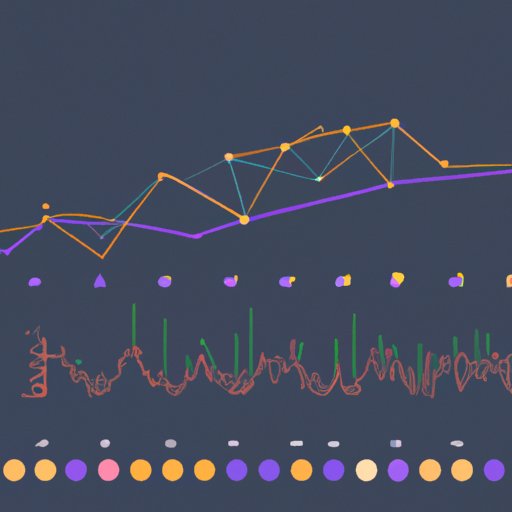Introduction
Graphs are a powerful tool used in various fields such as mathematics, engineering, and science. In science, graphs play an important role in helping researchers analyze, represent, and interpret data. By visualizing data, graphs make it easier for scientists to understand complex information and draw meaningful conclusions from their results.

Exploring the Basics of Graphs in Science
Before delving into the specifics of how graphs are used in scientific research, let’s first define what a graph is and explore some of the types and benefits of using them.
What is a Graph?
A graph is essentially a diagram that represents relationships between two or more variables. Graphs can be used to demonstrate various types of trends or patterns in data.
Types of Graphs
There are several different types of graphs used in science. Some of the most common include bar graphs, line graphs, scatter plots, histograms, pie charts, and network graphs.
Benefits of Using Graphs
Graphs have many advantages when it comes to scientific research. They provide an easy way to visualize data, making it easier to identify patterns and draw meaningful conclusions. Additionally, graphs allow researchers to compare different sets of data, which can be extremely helpful when analyzing results.

A Comprehensive Guide to Graphs and Their Uses in Scientific Research
Now that we have a basic understanding of what graphs are and why they are beneficial, let’s take a look at how they are used in scientific research.
Representing Data Visually
Graphs are often used to represent data visually. By plotting data points on a graph, scientists can easily see how different variables are related to each other. This makes it much easier to spot trends and identify correlations.
Analyzing and Interpreting Results
Graphs also make it easier for researchers to analyze and interpret their results. By plotting data points on a graph, researchers can quickly identify outliers and determine if there is any relationship between variables. This is especially useful when researching complex problems.
Comparing Results
Graphs are also useful for comparing different sets of data. For example, scientists can use graphs to compare the results of two experiments side-by-side. This allows them to quickly spot differences and draw meaningful conclusions from their results.
A Look at How Graphs are Used to Visualize Data in Science
Now that we know how graphs are used in scientific research, let’s take a look at some of the different types of graphs used to visualize data.
Scatter Plots
Scatter plots are commonly used to visualize relationships between two variables. These plots show the relationship between two variables by plotting each data point on a graph. Scatter plots are useful for identifying correlations between variables.
Bar Charts
Bar charts are used to compare different sets of data. They are composed of rectangular bars, with each bar representing a different category or value. Bar charts are helpful for comparing relative sizes and proportions.
Line Graphs
Line graphs are used to plot changes over time. These graphs are composed of a series of points connected by lines. Line graphs are useful for tracking trends and predicting future changes.
An Overview of Different Types of Graphs in Science
In addition to the graphs mentioned above, there are several other types of graphs used in scientific research. Let’s take a look at some of the most common.
Histograms
Histograms are used to visualize the distribution of numerical data. These graphs are composed of rectangles with heights proportional to the frequency of the data points. Histograms are helpful for understanding how data is distributed across different categories.
Pie Charts
Pie charts are used to visualize the proportions of different categories. These charts are composed of slices, with each slice representing a different category or value. Pie charts are useful for comparing relative sizes and proportions.
Network Graphs
Network graphs are used to visualize relationships between entities. These graphs are composed of nodes and edges, with each node representing an entity and each edge representing a connection between two entities. Network graphs are useful for understanding the structure of networks and identifying patterns in data.

Understanding the Value of Graphs in Scientific Discovery
Graphs are an invaluable tool for scientific research. They can help researchers analyze, represent, and interpret data in ways that would not be possible without them. Here are a few of the key benefits of using graphs in scientific research.
Clarifying Complex Data
One of the biggest benefits of using graphs is that they can help clarify complex data. By plotting data points on a graph, researchers can quickly identify patterns and draw meaningful conclusions from their results. According to a study published in PLOS ONE, “graphical representation of data is an effective way to simplify complex information and facilitate decision making” (Younis et al., 2017).
Communicating Results
Graphs can also be used to communicate research results. By visualizing data, graphs make it easier for scientists to explain their findings to others. This can be particularly helpful when presenting research to peers or the public.
Supporting Claims
Finally, graphs can be used to support claims. By visualizing data, graphs make it easier for researchers to identify patterns and draw meaningful conclusions from their results. This can be helpful when trying to prove or disprove a hypothesis.
Conclusion
Graphs are an essential tool in scientific research. They can help researchers analyze, represent, and interpret data in ways that would not be possible without them. From scatter plots to network graphs, there are many different types of graphs used in science. By understanding the basics of graphs and how they are used, researchers can more effectively use them to gain insights into their data and draw meaningful conclusions from their results.
(Note: Is this article not meeting your expectations? Do you have knowledge or insights to share? Unlock new opportunities and expand your reach by joining our authors team. Click Registration to join us and share your expertise with our readers.)
